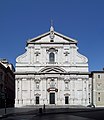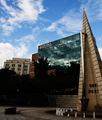Jesuits: Difference between revisions
Extended confirmed users 19,963 edits m →In science: moved external link to <ref> |
Extended confirmed users 6,083 edits Expanding bare references using ReferenceExpander |
||
| Line 36: | Line 36: | ||
The Society of Jesus is consecrated under the [[patron saint|patronage]] of [[Madonna della Strada]], a title of the [[Blessed Virgin Mary]], and it is led by a [[Superior General of the Society of Jesus|Superior General]].<ref>{{cite web |url=http://www.sjweb.info/35/index.cfm |title=News on the elections of the new Superior General |publisher=Sjweb.info |access-date=4 December 2011}}</ref><ref>{{cite news|url=http://africa.reuters.com/wire/news/usnL19414053.html|title= africa.reuters.com, Spaniard becomes Jesuits' new 'black pope' |publisher=Reuters |date=9 February 2009|access-date=4 December 2011|archive-url=https://web.archive.org/web/20090103160950/http://africa.reuters.com/wire/news/usnL19414053.html|archive-date=3 January 2009}}</ref> The headquarters of the society, its [[Curia|General Curia]], is in Rome.<ref>{{cite web |url=https://www.jesuits.global/fr-general/officials/|title=The General Curia|access-date=7 October 2022}}</ref> The historic curia of Ignatius is now part of the {{lang|es|Collegio del Gesù}} attached to the [[Church of the Gesù]], the Jesuit [[mother church]]. |
The Society of Jesus is consecrated under the [[patron saint|patronage]] of [[Madonna della Strada]], a title of the [[Blessed Virgin Mary]], and it is led by a [[Superior General of the Society of Jesus|Superior General]].<ref>{{cite web |url=http://www.sjweb.info/35/index.cfm |title=News on the elections of the new Superior General |publisher=Sjweb.info |access-date=4 December 2011}}</ref><ref>{{cite news|url=http://africa.reuters.com/wire/news/usnL19414053.html|title= africa.reuters.com, Spaniard becomes Jesuits' new 'black pope' |publisher=Reuters |date=9 February 2009|access-date=4 December 2011|archive-url=https://web.archive.org/web/20090103160950/http://africa.reuters.com/wire/news/usnL19414053.html|archive-date=3 January 2009}}</ref> The headquarters of the society, its [[Curia|General Curia]], is in Rome.<ref>{{cite web |url=https://www.jesuits.global/fr-general/officials/|title=The General Curia|access-date=7 October 2022}}</ref> The historic curia of Ignatius is now part of the {{lang|es|Collegio del Gesù}} attached to the [[Church of the Gesù]], the Jesuit [[mother church]]. |
||
Members of the Society of Jesus are expected to accept orders to go anywhere in the world, where they might be required to live in extreme conditions. This was so because Ignatius, its leading founder, was a nobleman who had a military background. Accordingly, the opening lines of the founding document declared that the society was founded for "whoever desires to serve as a soldier of God,{{efn|[[Spanish language|Spanish]]: "{{lang|es|todo el que quiera militar para Dios}}{{-"}}<ref> |
Members of the Society of Jesus are expected to accept orders to go anywhere in the world, where they might be required to live in extreme conditions. This was so because Ignatius, its leading founder, was a nobleman who had a military background. Accordingly, the opening lines of the founding document declared that the society was founded for "whoever desires to serve as a soldier of God,{{efn|[[Spanish language|Spanish]]: "{{lang|es|todo el que quiera militar para Dios}}{{-"}}<ref>{{Cite web|title="Fórmula del Instituto""Todo el - Tìm trên Google|url=http://www.google.com/search?&tbm=bks&q=%2522F%25C3%25B3rmula+del+Instituto%2522%2522Todo+el+|access-date=2023-01-16|website=www.google.com}}</ref>}} to strive especially for the defense and propagation of the faith, and for the progress of souls in Christian life and doctrine".{{sfn|O'Malley|2006|p=xxxv}} Jesuits are thus sometimes referred to colloquially as "God's soldiers",<ref>{{cite news |url=https://www.npr.org/templates/story/story.php?storyId=124357786 |title=Poverty and Chastity for Every Occasion |work=Weekend Edition Saturday |publisher=[[NPR|National Public Radio]] |date=5 March 2010 |access-date=15 May 2013}}</ref> "God's marines",<ref>{{cite magazine |date=23 March 2013| title=The Jesuits: 'God's marines' |url=http://theweek.com/articles/466362/jesuits-gods-marines |magazine=The Week |location=New York |access-date=19 June 2017}}</ref> or "the Company".<ref>{{cite web|url=http://www.ignatiushouse.org/spirituality/the-jesuits/|title=About Our Jesuits |publisher=Ignatius House Retreat Center|location=Atlanta, Georgia| access-date=15 May 2013|archive-url=https://web.archive.org/web/20130411070204/http://www.ignatiushouse.org/spirituality/the-jesuits/|archive-date=2013-04-11}}</ref> The society participated in the [[Counter-Reformation]] and, later, in the implementation of the [[Second Vatican Council]]. |
||
==History== |
==History== |
||
| Line 44: | Line 44: | ||
[[Ignatius of Loyola]], a [[Basques|Basque]] nobleman from the [[Pyrenees]] area of northern Spain, founded the society after discerning his spiritual vocation while recovering from a wound sustained in the [[List of battles of the Italian Wars#Pampeluna|Battle of Pamplona]]. He composed the ''[[Spiritual Exercises of Ignatius of Loyola|Spiritual Exercises]]'' to help others follow the teachings of [[Jesus Christ]]. In 1534, Ignatius and six other young men, including [[Francis Xavier]] and [[Peter Faber]], gathered and professed promises of [[Evangelical counsels|poverty, chastity, and later obedience]], including a special vow of obedience to the pope in matters of mission direction and assignment. Ignatius's plan of the order's organization was approved by [[Pope Paul III]] in 1540 by a [[Papal bull|bull]] containing the "Formula of the Institute". |
[[Ignatius of Loyola]], a [[Basques|Basque]] nobleman from the [[Pyrenees]] area of northern Spain, founded the society after discerning his spiritual vocation while recovering from a wound sustained in the [[List of battles of the Italian Wars#Pampeluna|Battle of Pamplona]]. He composed the ''[[Spiritual Exercises of Ignatius of Loyola|Spiritual Exercises]]'' to help others follow the teachings of [[Jesus Christ]]. In 1534, Ignatius and six other young men, including [[Francis Xavier]] and [[Peter Faber]], gathered and professed promises of [[Evangelical counsels|poverty, chastity, and later obedience]], including a special vow of obedience to the pope in matters of mission direction and assignment. Ignatius's plan of the order's organization was approved by [[Pope Paul III]] in 1540 by a [[Papal bull|bull]] containing the "Formula of the Institute". |
||
On 15 August 1534, Ignatius of Loyola (born Íñigo López de Loyola), a Spaniard from the [[Basque Country (autonomous community)|Basque]] city of [[Sanctuary of Loyola|Loyola]], and six others mostly of [[Castilian people|Castilian]] origin, all students at the [[University of Paris]],<ref> |
On 15 August 1534, Ignatius of Loyola (born Íñigo López de Loyola), a Spaniard from the [[Basque Country (autonomous community)|Basque]] city of [[Sanctuary of Loyola|Loyola]], and six others mostly of [[Castilian people|Castilian]] origin, all students at the [[University of Paris]],<ref>{{Cite web|title=How to Write a Research Paper: Total Guide for Beginners | michaelservetusresearch.com|url=https://michaelservetusresearch.com/,%2520https://michaelservetusresearch.com/|access-date=2023-01-16|language=en-US}}</ref> met in [[Montmartre]] outside Paris, in a crypt beneath the church of [[Saint Denis of Paris|Saint Denis]], now [[Saint Pierre de Montmartre]], to pronounce promises of poverty, chastity, and obedience.{{sfn|Campbell|1921|p=24}} Ignatius' six companions were: [[Francis Xavier|Francisco Xavier]] from [[Kingdom of Navarre|Navarre]] ([[Spain|modern Spain]]), [[Alfonso Salmeron]], [[Diego Laynez|Diego Laínez]], [[Nicholas Bobadilla|Nicolás Bobadilla]] from [[Crown of Castile|Castile]] ([[Spain|modern Spain]]), [[Peter Faber]] from [[Savoy]], and [[Simão Rodrigues]] from [[Portugal]].{{sfn|Coyle|1908|p=142}} The meeting has been commemorated in the [[Martyrium of Saint Denis, Montmartre]]. They called themselves the {{lang|es|Compañía de Jesús}}, and also {{lang|es|Amigos en El Señor}} or "Friends in the Lord", because they felt "they were placed together by Christ." The name "company" had echoes of the military (reflecting perhaps Ignatius' background as Captain in the Spanish army) as well as of discipleship (the "companions" of Jesus). The Spanish "company" would be translated into Latin as {{lang|la|societas}} like in {{lang|la|socius}}, a partner or comrade. From this came "Society of Jesus" (SJ) by which they would be known more widely.<ref>{{Cite web|url=http://www.reformation.org/jesuits2.html|title=Chapter 2|website=www.reformation.org|access-date=30 May 2017|archive-date=2 January 2018|archive-url=https://web.archive.org/web/20180102071515/http://www.reformation.org/jesuits2.html}}</ref> |
||
Religious orders established in the medieval era were named after particular men: [[Francis of Assisi]] (Franciscans); [[Saint Dominic|Domingo de Guzmán]], later canonized as Saint Dominic (Dominicans); and [[Augustine of Hippo]] (Augustinians). Ignatius of Loyola and his followers appropriated the name of Jesus for their new order, provoking resentment by other orders who considered it presumptuous. The resentment was recorded by Jesuit [[José de Acosta]] of a conversation with the Archbishop of Santo Domingo.{{sfn|Brading|1991|p=166}} In the words of one historian: "The use of the name Jesus gave great offense. Both on the Continent and in England, it was denounced as blasphemous; petitions were sent to kings and to civil and ecclesiastical tribunals to have it changed; and even [[Pope Sixtus V]] had signed a Brief to do away with it." But nothing came of all the opposition; there were already congregations named after the Trinity and as "God's daughters".{{sfn|Campbell|1921|p=7}} |
Religious orders established in the medieval era were named after particular men: [[Francis of Assisi]] (Franciscans); [[Saint Dominic|Domingo de Guzmán]], later canonized as Saint Dominic (Dominicans); and [[Augustine of Hippo]] (Augustinians). Ignatius of Loyola and his followers appropriated the name of Jesus for their new order, provoking resentment by other orders who considered it presumptuous. The resentment was recorded by Jesuit [[José de Acosta]] of a conversation with the Archbishop of Santo Domingo.{{sfn|Brading|1991|p=166}} In the words of one historian: "The use of the name Jesus gave great offense. Both on the Continent and in England, it was denounced as blasphemous; petitions were sent to kings and to civil and ecclesiastical tribunals to have it changed; and even [[Pope Sixtus V]] had signed a Brief to do away with it." But nothing came of all the opposition; there were already congregations named after the Trinity and as "God's daughters".{{sfn|Campbell|1921|p=7}} |
||
| Line 103: | Line 103: | ||
[[File:Bell of Nanban-ji.JPG|thumb|left|[[Shunkō-in|Bell]] made in Portugal for [[Nanban trade#Other Nanban influences|Nanbanji Church]] run by Jesuits in Japan, 1576–1587]] |
[[File:Bell of Nanban-ji.JPG|thumb|left|[[Shunkō-in|Bell]] made in Portugal for [[Nanban trade#Other Nanban influences|Nanbanji Church]] run by Jesuits in Japan, 1576–1587]] |
||
Jesuit scholars working in foreign missions were very dedicated in studying the local languages and strove to produce Latinized [[grammar]]s and [[dictionary|dictionaries]]. This included: Japanese (see {{transliteration|ja|[[Nippo jisho]]}}, also known as {{lang|es|Vocabvlario da Lingoa de Iapam}}, "Vocabulary of the Japanese Language", a Japanese–Portuguese dictionary written 1603); [[Vietnamese language|Vietnamese]] (Portuguese missionaries created the [[Vietnamese alphabet]],<ref name="Jacques 2002">{{cite book|last1=Jacques|first1=Roland|title=Portuguese Pioneers of Vietnamese Linguistics Prior to 1650 – Pionniers Portugais de la Linguistique Vietnamienne Jusqu'en 1650|date=2002|publisher=Orchid Press|location=Bangkok, Thailand|isbn=974-8304-77-9|language=en, fr}}</ref><ref name="Jacques 2004"> |
Jesuit scholars working in foreign missions were very dedicated in studying the local languages and strove to produce Latinized [[grammar]]s and [[dictionary|dictionaries]]. This included: Japanese (see {{transliteration|ja|[[Nippo jisho]]}}, also known as {{lang|es|Vocabvlario da Lingoa de Iapam}}, "Vocabulary of the Japanese Language", a Japanese–Portuguese dictionary written 1603); [[Vietnamese language|Vietnamese]] (Portuguese missionaries created the [[Vietnamese alphabet]],<ref name="Jacques 2002">{{cite book|last1=Jacques|first1=Roland|title=Portuguese Pioneers of Vietnamese Linguistics Prior to 1650 – Pionniers Portugais de la Linguistique Vietnamienne Jusqu'en 1650|date=2002|publisher=Orchid Press|location=Bangkok, Thailand|isbn=974-8304-77-9|language=en, fr}}</ref><ref name="Jacques 2004">{{Cite web|title=Roland4|url=http://ttntt.free.fr/archive/Roland4.html|access-date=2023-01-16|website=ttntt.free.fr}}</ref> which was later formalized by Avignon missionary [[Alexandre de Rhodes]] with his 1651 [[Dictionarium Annamiticum Lusitanum et Latinum|trilingual dictionary]]); [[Tupi language|Tupi]] (the main language of Brazil); and the pioneering study of [[Sanskrit]] in the West by [[Jean François Pons]] in the 1740s. |
||
Jesuit missionaries were active among [[indigenous peoples]] in [[New France]] in North America, many of them compiling dictionaries or glossaries of the [[First Nations in Canada|First Nations]] and Native American languages they had learned. For instance, before his death in 1708, [[Jacques Gravier]], vicar general of the [[Illinois]] [[Mission (Christian)|Mission]] in the [[Mississippi River]] valley, compiled a Kaskaskia Illinois–French [[dictionary]], considered the most extensive among works of the missionaries.{{sfn|Adelaar|2004}} Extensive documentation was left in the form of ''[[The Jesuit Relations]]'', published annually from 1632 until 1673. |
Jesuit missionaries were active among [[indigenous peoples]] in [[New France]] in North America, many of them compiling dictionaries or glossaries of the [[First Nations in Canada|First Nations]] and Native American languages they had learned. For instance, before his death in 1708, [[Jacques Gravier]], vicar general of the [[Illinois]] [[Mission (Christian)|Mission]] in the [[Mississippi River]] valley, compiled a Kaskaskia Illinois–French [[dictionary]], considered the most extensive among works of the missionaries.{{sfn|Adelaar|2004}} Extensive documentation was left in the form of ''[[The Jesuit Relations]]'', published annually from 1632 until 1673. |
||
| Line 142: | Line 142: | ||
By 1700, Jesuits turned to maintaining Quebec, Montreal, and Ottawa without establishing new posts.{{sfn|Kennedy|1950|p=49}} During the [[Seven Years' War]], Quebec was [[Conquest of New France (1758–1760)|captured by the British]] in 1759 and New France came under British control. The British barred the immigration of more Jesuits to New France, and by 1763, there were only 21 Jesuits stationed in New France. By 1773 only 11 Jesuits remained. During the same year the British crown laid claim to New France and declared that the Society of Jesus in New France was dissolved.{{sfn|Kennedy|1950|p=53}} |
By 1700, Jesuits turned to maintaining Quebec, Montreal, and Ottawa without establishing new posts.{{sfn|Kennedy|1950|p=49}} During the [[Seven Years' War]], Quebec was [[Conquest of New France (1758–1760)|captured by the British]] in 1759 and New France came under British control. The British barred the immigration of more Jesuits to New France, and by 1763, there were only 21 Jesuits stationed in New France. By 1773 only 11 Jesuits remained. During the same year the British crown laid claim to New France and declared that the Society of Jesus in New France was dissolved.{{sfn|Kennedy|1950|p=53}} |
||
The dissolution of the Order left in place substantial estates and investments, amounting to an income of approximately £5,000 a year, and the [[Council for the Affairs of the Province of Quebec]], later succeeded by the [[Legislative Assembly of Quebec]], assumed the task of allocating the funds to suitable recipients, chiefly schools.<ref> |
The dissolution of the Order left in place substantial estates and investments, amounting to an income of approximately £5,000 a year, and the [[Council for the Affairs of the Province of Quebec]], later succeeded by the [[Legislative Assembly of Quebec]], assumed the task of allocating the funds to suitable recipients, chiefly schools.<ref>{{Cite book|last=Canada|url=http://archive.org/details/provincialstatu01canagoog|title=The provincial statutes of Canada|date=1841|publisher=Kingston : S. Derbishire & G. Desbarats, Law Printer to the Queen's Most Excellent Majesty|others=unknown library}}</ref> |
||
The Jesuit mission in Quebec was re-established in 1842. There were a number of Jesuit colleges founded in the decades following; one of these colleges evolved into present-day [[Université Laval|Laval University]].<ref> |
The Jesuit mission in Quebec was re-established in 1842. There were a number of Jesuit colleges founded in the decades following; one of these colleges evolved into present-day [[Université Laval|Laval University]].<ref>{{Cite web|title=Jesuits | The Canadian Encyclopedia|url=https://www.thecanadianencyclopedia.ca/en/article/jesuits|access-date=2023-01-16|website=www.thecanadianencyclopedia.ca}}</ref> |
||
====United States==== |
====United States==== |
||
| Line 397: | Line 397: | ||
===Rescue efforts during the Holocaust=== |
===Rescue efforts during the Holocaust=== |
||
{{Further|Rescue of Jews by Catholics during the Holocaust}} |
{{Further|Rescue of Jews by Catholics during the Holocaust}} |
||
In his history of the heroes of the Holocaust, the Jewish historian [[Martin Gilbert]] notes that in every country under German occupation, priests played a major part in rescuing Jews, and that the Jesuits were one of the Catholic Orders that hid Jewish children in monasteries and schools to protect them from the Nazis.<ref>Martin Gilbert; The Righteous – The Unsung Heroes of the Holocaust; Doubleday; 2002; {{ISBN|0-385-60100-X}}; p. 299</ref><ref name="ReferenceA">Martin Gilbert; ''The Righteous: the Unsung Heroes of the Holocaust''; Holt Paperback; New York; 2004; Preface</ref> Fourteen Jesuit priests have been formally recognized by [[Yad Vashem]], the [[Holocaust]] Martyrs' and Heroes' Remembrance Authority in Jerusalem, for risking their lives to save Jews during the Holocaust of World War II: Roger Braun (1910–1981) of France,<ref>[http://db.yadvashem.org/righteous/righteousName.html?language=en&itemId=4042776 Braun Roger (1910–1981)] {{Webarchive|url=https://web.archive.org/web/20221204170420/https://righteous.yadvashem.org/index.html?language=en&itemId=4042776 |date=4 December 2022 }}, Yad Vashem</ref> [[Pierre Chaillet]] (1900–1972) of France,<ref> |
In his history of the heroes of the Holocaust, the Jewish historian [[Martin Gilbert]] notes that in every country under German occupation, priests played a major part in rescuing Jews, and that the Jesuits were one of the Catholic Orders that hid Jewish children in monasteries and schools to protect them from the Nazis.<ref>Martin Gilbert; The Righteous – The Unsung Heroes of the Holocaust; Doubleday; 2002; {{ISBN|0-385-60100-X}}; p. 299</ref><ref name="ReferenceA">Martin Gilbert; ''The Righteous: the Unsung Heroes of the Holocaust''; Holt Paperback; New York; 2004; Preface</ref> Fourteen Jesuit priests have been formally recognized by [[Yad Vashem]], the [[Holocaust]] Martyrs' and Heroes' Remembrance Authority in Jerusalem, for risking their lives to save Jews during the Holocaust of World War II: Roger Braun (1910–1981) of France,<ref>[http://db.yadvashem.org/righteous/righteousName.html?language=en&itemId=4042776 Braun Roger (1910–1981)] {{Webarchive|url=https://web.archive.org/web/20221204170420/https://righteous.yadvashem.org/index.html?language=en&itemId=4042776 |date=4 December 2022 }}, Yad Vashem</ref> [[Pierre Chaillet]] (1900–1972) of France,<ref>{{Cite web|title=The Righteous Among The Nations|url=https://righteous.yadvashem.org/|access-date=2023-01-16|website=The Righteous Among The Nations}}</ref> [[Jean-Baptist De Coster (Jesuit)|Jean-Baptist De Coster]] (1896–1968) of Belgium,<ref>[http://db.yadvashem.org/righteous/family.html?language=en&itemId=4042720 De Coster, Father Jean-Baptiste] {{Webarchive|url=https://web.archive.org/web/20200531083547/https://righteous.yadvashem.org/index.html?language=en&itemId=4042720 |date=31 May 2020 }}, Yad Vashem</ref> Jean Fleury (1905–1982) of France,<ref>[http://db. yadvashem.org/righteous/family.html?language=en&itemId=4042826 Fleury Jean (1905–1982)] {{Webarchive|url=https://web.archive.org/web/20151208203654/http://db.yadvashem.org/righteous/family.html?language=en&itemId=4042826 |date=8 December 2015 }}, Yad Vashem</ref> Emile Gessler (1891–1958) of Belgium, [[Jean-Baptiste Janssens]] (1889–1964) of Belgium, Alphonse Lambrette (1884–1970) of Belgium, Emile Planckaert (1906–2006) of France, Jacob Raile (1894–1949) of Hungary, Henri Revol (1904–1992) of France, Adam Sztark (1907–1942) of Poland, Henri Van Oostayen (1906–1945) of Belgium, Ioannes Marangas (1901–1989) of Greece, and Raffaele de Chantuz Cubbe (1904–1983) of Italy.<ref>Vincent A. Lapomarda, ''The Jesuits and the Third Reich'' ([[Lewiston, New York]]: [[Edwin Mellen Press]], 1989).</ref> |
||
Several other Jesuits are known to have rescued or given refuge to Jews during that period.<ref>{{cite web|url=http://www.holycross.edu/departments/library/website/hiatt/righteous.htm|title=Hiatt Holocaust Collection|publisher= Holycross. edu|access-date=4 December 2011|archive-url=https://web.archive.org/web/20100528010951/http://www.holycross.edu/departments/library/website/hiatt/righteous.htm|archive-date=28 May 2010}}</ref> A plaque commemorating the 152 Jesuit priests who gave their lives during the Holocaust was installed in April 2007 at the Jesuits' [[Rockhurst University]] in [[Kansas City, Missouri]], United States. |
Several other Jesuits are known to have rescued or given refuge to Jews during that period.<ref>{{cite web|url=http://www.holycross.edu/departments/library/website/hiatt/righteous.htm|title=Hiatt Holocaust Collection|publisher= Holycross. edu|access-date=4 December 2011|archive-url=https://web.archive.org/web/20100528010951/http://www.holycross.edu/departments/library/website/hiatt/righteous.htm|archive-date=28 May 2010}}</ref> A plaque commemorating the 152 Jesuit priests who gave their lives during the Holocaust was installed in April 2007 at the Jesuits' [[Rockhurst University]] in [[Kansas City, Missouri]], United States. |
||
| Line 404: | Line 404: | ||
{{See also|List of Jesuit scientists}}[[File:Jesuites en chine.jpg|thumb|[[Jesuit China missions|Jesuit]] scholars in [[China]]. Top: [[Matteo Ricci]], [[Adam Schall von Bell|Adam Schall]] and [[Ferdinand Verbiest]] (1623–88); Bottom: [[Xu Guangqi|Paul Siu (Xu Guangqi)]], ''Colao'' or Prime Minister of State, and his granddaughter Candide Hiu.]] |
{{See also|List of Jesuit scientists}}[[File:Jesuites en chine.jpg|thumb|[[Jesuit China missions|Jesuit]] scholars in [[China]]. Top: [[Matteo Ricci]], [[Adam Schall von Bell|Adam Schall]] and [[Ferdinand Verbiest]] (1623–88); Bottom: [[Xu Guangqi|Paul Siu (Xu Guangqi)]], ''Colao'' or Prime Minister of State, and his granddaughter Candide Hiu.]] |
||
Between the sixteenth and eighteenth centuries, the teaching of science in Jesuit schools, as laid down in the ''Ratio atque Institutio Studiorum Societatis Iesu'' ("The Official Plan of studies for the Society of Jesus") of 1599,<ref> |
Between the sixteenth and eighteenth centuries, the teaching of science in Jesuit schools, as laid down in the ''Ratio atque Institutio Studiorum Societatis Iesu'' ("The Official Plan of studies for the Society of Jesus") of 1599,<ref>{{Cite web|date=2017-12-27|title=Wayback Machine|url=https://web.archive.org/web/20171227101629/http://www.bc.edu/sites/libraries/ratio/ratio1599.pdf|access-date=2023-01-16|website=web.archive.org}}</ref> was almost entirely based on the works of Aristotle. |
||
The Jesuits, nevertheless, have made numerous significant contributions to the development of science. For example, the Jesuits have dedicated significant study to fields from [[cosmology]] to [[seismology]], the latter of which has been described as "the Jesuit science".{{sfn|Hough|2007|p=68}} The Jesuits have been described as "the single most important contributor to experimental physics in the seventeenth century".{{sfn|Ashworth|1986|p=154}} According to [[Jonathan Wright (historian)|Jonathan Wright]] in his book ''God's Soldiers'', by the eighteenth century the Jesuits had "contributed to the development of [[pendulum clock]]s, [[pantograph]]s, [[barometer]]s, [[reflecting telescope]]s and [[microscope]]s – to scientific fields as various as [[magnetism]], [[optics]], and [[electricity]]. They observed, in some cases before anyone else, the colored bands on [[Jupiter]]'s surface, the [[Andromeda Galaxy|Andromeda nebula]], and [[Saturn]]'s rings. They theorized about the circulation of the blood (independently of [[William Harvey|Harvey]]), the theoretical possibility of flight, the way the moon affected the tides, and the wave-like nature of light."{{sfn|Wright|2004|p=200}} |
The Jesuits, nevertheless, have made numerous significant contributions to the development of science. For example, the Jesuits have dedicated significant study to fields from [[cosmology]] to [[seismology]], the latter of which has been described as "the Jesuit science".{{sfn|Hough|2007|p=68}} The Jesuits have been described as "the single most important contributor to experimental physics in the seventeenth century".{{sfn|Ashworth|1986|p=154}} According to [[Jonathan Wright (historian)|Jonathan Wright]] in his book ''God's Soldiers'', by the eighteenth century the Jesuits had "contributed to the development of [[pendulum clock]]s, [[pantograph]]s, [[barometer]]s, [[reflecting telescope]]s and [[microscope]]s – to scientific fields as various as [[magnetism]], [[optics]], and [[electricity]]. They observed, in some cases before anyone else, the colored bands on [[Jupiter]]'s surface, the [[Andromeda Galaxy|Andromeda nebula]], and [[Saturn]]'s rings. They theorized about the circulation of the blood (independently of [[William Harvey|Harvey]]), the theoretical possibility of flight, the way the moon affected the tides, and the wave-like nature of light."{{sfn|Wright|2004|p=200}} |
||
Revision as of 10:02, 16 January 2023
Madonna della Strada) | |
Ministry | Missionary, educational, literary works |
|---|---|
Main organ | La Civiltà Cattolica |
Parent organization | Catholic Church |
| Website | www |
| Part of a series on the |
| Society of Jesus |
|---|
 |
| History |
| Hierarchy |
|
| Spirituality |
| Works |
| Notable Jesuits |
|
Catholicism portal |
The Society of Jesus (
The Society of Jesus is consecrated under the
Members of the Society of Jesus are expected to accept orders to go anywhere in the world, where they might be required to live in extreme conditions. This was so because Ignatius, its leading founder, was a nobleman who had a military background. Accordingly, the opening lines of the founding document declared that the society was founded for "whoever desires to serve as a soldier of God,[a] to strive especially for the defense and propagation of the faith, and for the progress of souls in Christian life and doctrine".[9] Jesuits are thus sometimes referred to colloquially as "God's soldiers",[10] "God's marines",[11] or "the Company".[12] The society participated in the Counter-Reformation and, later, in the implementation of the Second Vatican Council.
History
Foundation

On 15 August 1534, Ignatius of Loyola (born Íñigo López de Loyola), a Spaniard from the
Religious orders established in the medieval era were named after particular men: Francis of Assisi (Franciscans); Domingo de Guzmán, later canonized as Saint Dominic (Dominicans); and Augustine of Hippo (Augustinians). Ignatius of Loyola and his followers appropriated the name of Jesus for their new order, provoking resentment by other orders who considered it presumptuous. The resentment was recorded by Jesuit José de Acosta of a conversation with the Archbishop of Santo Domingo.[17] In the words of one historian: "The use of the name Jesus gave great offense. Both on the Continent and in England, it was denounced as blasphemous; petitions were sent to kings and to civil and ecclesiastical tribunals to have it changed; and even Pope Sixtus V had signed a Brief to do away with it." But nothing came of all the opposition; there were already congregations named after the Trinity and as "God's daughters".[18]
In 1537, the seven travelled to Italy to seek papal approval for their
They were ordained in
Again in 1540, they presented the project to Paul III. After months of dispute, a congregation of
In 1543, Pierre Canisius entered the Company. Ignatius sent him to Messina, where he founded the first Jesuit college in Sicily.
Ignatius laid out his original vision for the new order in the "Formula of the Institute of the Society of Jesus",[20] which is "the fundamental charter of the order, of which all subsequent official documents were elaborations and to which they had to conform".[21] He ensured that his formula was contained in two papal bulls signed by Pope Paul III in 1540 and by Pope Julius III in 1550.[20] The formula expressed the nature, spirituality, community life, and apostolate of the new religious order. Its famous opening statement echoed Ignatius' military background:
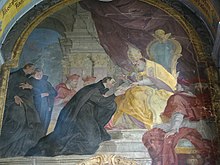
Whoever desires to serve as a soldier of God beneath the banner of the Cross in our Society, which we desire to be designated by the Name of Jesus, and to serve the Lord alone and the Church, his spouse, under the Roman Pontiff, the Vicar of Christ on earth, should, after a solemn vow of perpetual chastity, poverty and obedience, keep what follows in mind. He is a member of a Society founded chiefly for this purpose: to strive especially for the defence and propagation of the faith and for the progress of souls in Christian life and doctrine, by means of public preaching, lectures and any other ministration whatsoever of the Word of God, and further by means of retreats, the education of children and unlettered persons in Christianity, and the spiritual consolation of Christ's faithful through hearing confessions and administering the other sacraments. Moreover, he should show himself ready to reconcile the estranged, compassionately assist and serve those who are in prisons or hospitals, and indeed, to perform any other works of charity, according to what will seem expedient for the glory of God and the common good.[22]

In fulfilling the mission of the "Formula of the Institute of the Society", the first Jesuits concentrated on a few key activities. First, they founded schools throughout Europe. Jesuit teachers were trained in both classical studies and theology, and their schools reflected this. Second, they sent out missionaries across the globe to evangelize those peoples who had not yet heard the Gospel, founding missions in widely diverse regions such as modern-day Paraguay, Japan, Ontario, and Ethiopia. One of the original seven arrived in India already in 1541.[23] Finally, though not initially formed for the purpose, they aimed to stop Protestantism from spreading and to preserve communion with Rome and the pope. The zeal of the Jesuits overcame the movement toward Protestantism in the Polish–Lithuanian Commonwealth and southern Germany.
Ignatius wrote the Jesuit Constitutions, adopted in 1553, which created a centralised organization and stressed acceptance of any mission to which the pope might call them.
The Society of Jesus is classified among institutes as a
The term Jesuit (of 15th-century origin, meaning "one who used too frequently or appropriated the name of Jesus") was first applied to the society in reproach (1544–1552).[27] The term was never used by Ignatius of Loyola, but over time, members and friends of the society adopted the name with a positive meaning.[18]
Early works

This section needs additional citations for verification. (August 2020) |
The Jesuits were founded just before the
Ignatius and the early Jesuits did recognize, though, that the hierarchical church was in dire need of reform. Some of their greatest struggles were against corruption, venality, and spiritual lassitude within the Catholic Church. Ignatius insisted on a high level of academic preparation for the clergy in contrast to the relatively poor education of much of the clergy of his time. The Jesuit vow against "ambitioning prelacies" can be seen as an effort to counteract another problem evidenced in the preceding century.
Ignatius and the Jesuits who followed him believed that the reform of the church had to begin with the conversion of an individual's heart. One of the main tools the Jesuits have used to bring about this conversion is the Ignatian retreat, called the
The retreat follows a "Purgative-Illuminative-Unitive" pattern in the tradition of the spirituality of John Cassian and the Desert Fathers. Ignatius' innovation was to make this style of contemplative mysticism available to all people in active life. Further, he used it as a means of rebuilding the spiritual life of the church. The Exercises became both the basis for the training of Jesuits and one of the essential ministries of the order: giving the exercises to others in what became known as "retreats".
The Jesuits' contributions to the late
In addition to the teachings of faith, the Jesuit Ratio Studiorum (1599) would standardize the study of Latin, Greek, classical literature, poetry, and philosophy as well as non-European languages, sciences, and the arts. Furthermore, Jesuit schools encouraged the study of vernacular literature and rhetoric, and thereby became important centres for the training of lawyers and public officials.
The Jesuit schools played an important part in winning back to Catholicism a number of European countries which had for a time been predominantly Protestant, notably Poland and Lithuania. Today, Jesuit colleges and universities are located in over one hundred nations around the world. Under the notion that God can be encountered through created things and especially art, they encouraged the use of ceremony and decoration in Catholic ritual and devotion. Perhaps as a result of this appreciation for art, coupled with their spiritual practice of "finding God in all things", many early Jesuits distinguished themselves in the visual and performing arts as well as in music. The theater was a form of expression especially prominent in Jesuit schools.[28]
Jesuit priests often acted as confessors to kings during the early modern period. They were an important force in the Counter-Reformation and in the Catholic missions, in part because their relatively loose structure (without the requirements of living and celebration of the Liturgy of Hours in common) allowed them to be flexible and meet diverse needs arising at the time.[29]
Expansion of the order
This section may be confusing or unclear to readers. (December 2019) |
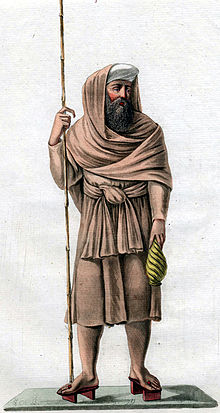
After much training and experience in theology, Jesuits went across the globe in search of converts to Christianity. Despite their dedication, they had little success in Asia, except in the

The Portuguese Jesuit
Jesuit

Jesuit scholars working in foreign missions were very dedicated in studying the local languages and strove to produce Latinized
Jesuit missionaries were active among
Britain
Whereas Jesuits were active in the 16th century, due to the prosecution of Catholics in the Elizabethan times, an 'English' province was only established in 1623.
China
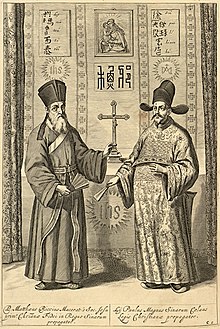


The Jesuits first entered China through the
The
[The Jesuits] made efforts to translate western mathematical and astronomical works into Chinese and aroused the interest of Chinese scholars in these sciences. They made very extensive astronomical observation and carried out the first modern cartographic work in China. They also learned to appreciate the scientific achievements of this ancient culture and made them known in Europe. Through their correspondence, European scientists first learned about the Chinese science and culture.[40]
For over a century, Jesuits like
Upon the arrival of the
Canada

During the French colonisation of
The Jesuits became involved in the
In 1639, Jesuit
After the collapse of the Huron nation, the Jesuits were to undertake the task of converting the Iroquois, something they had attempted in 1642 with little success. In 1653 the Iroquois nation had a fallout with the Dutch. They then signed a peace treaty with the French and a mission was established. The Iroquois took the treaty lightly and soon turned on the French again. In 1658, the Jesuits were having very little success and were under constant threat of being tortured or killed,[59] but continued their effort until 1687 when they abandoned their permanent posts in the Iroquois homeland.[61]
By 1700, Jesuits turned to maintaining Quebec, Montreal, and Ottawa without establishing new posts.
The dissolution of the Order left in place substantial estates and investments, amounting to an income of approximately £5,000 a year, and the
The Jesuit mission in Quebec was re-established in 1842. There were a number of Jesuit colleges founded in the decades following; one of these colleges evolved into present-day Laval University.[65]
United States
In the United States, the order is best known for its
The Society of Jesus, in the United States, is organized into geographic provinces, each of which being headed by a provincial superior. Today, there are four Jesuit provinces operating in the United States: the USA East, USA Central and Southern, USA Midwest, and USA West Provinces. At their height, there were ten provinces. Though there had been mergers in the past, a major reorganization of the provinces began in early 21st century, with the aim of consolidating into four provinces by 2020.[66]
Ecuador
The
Over the 160 years of its construction, the architects of la Compañía incorporated elements of four architectural styles, although the
Mexico
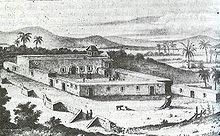

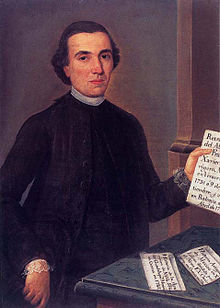
The Jesuits in
To support their colegios and members of the Society of Jesus, the Jesuits acquired landed estates that were run with the best-practices for generating income in that era. A number of these haciendas were donated by wealthy elites. The donation of a hacienda to the Jesuits was the spark igniting a conflict between 17th-century bishop of Puebla Don Juan de Palafox and the Jesuit colegio in that city. Since the Jesuits resisted paying the tithe on their estates, this donation effectively took revenue out of the church hierarchy's pockets by removing it from the tithe rolls.[67]
Many of Jesuit haciendas were huge, with Palafox asserting that just two colleges owned 300,000 head of sheep, whose wool was transformed locally in Puebla to cloth; six sugar plantations worth a million pesos and generating an income of 100,000 pesos.[67] The immense Jesuit hacienda of Santa Lucía produced pulque, the fermented juice of the agave cactus whose main consumers were the lower classes and indigenous peoples in Spanish cities. Although most haciendas had a free work force of permanent or seasonal labourers, the Jesuit haciendas in Mexico had a significant number of black slaves.[68]
The Jesuits operated their properties as an integrated unit with the larger Jesuit order; thus revenues from haciendas funded their colegios. Jesuits did significantly expand missions to the indigenous in the northern frontier area and a number were martyred, but the crown supported those missions.[67] Mendicant orders that had real estate were less economically integrated, so that some individual houses were wealthy while others struggled economically. The Franciscans, who were founded as an order embracing poverty, did not accumulate real estate, unlike the Augustinians and Dominicans in Mexico.
The Jesuits engaged in conflict with the episcopal hierarchy over the question of payment of tithes, the ten percent tax on agriculture levied on landed estates for support of the church hierarchy from bishops and cathedral chapters to parish priests. Since the Jesuits were the largest religious order holding real estate, surpassing the Dominicans and Augustinians who had accumulated significant property, this was no small matter.
As elsewhere in the Spanish empire, the Jesuits were expelled from Mexico in 1767. Their haciendas were sold off and their colegios and missions in Baja California were taken over by other orders.[70] Exiled Mexican-born Jesuit Francisco Javier Clavijero wrote an important history of Mexico while in Italy, a basis for creole patriotism. Andrés Cavo also wrote an important text on Mexican history that Carlos María de Bustamante published in the early nineteenth-century.[71] An earlier Jesuit who wrote about the history of Mexico was Diego Luis de Motezuma (1619–99), a descendant of the Aztec monarchs of Tenochtitlan. Motezuma's Corona mexicana, o Historia de los nueve Motezumas was completed in 1696. He "aimed to show that Mexican emperors were a legitimate dynasty in the 17th-century in the European sense".[72][73]
The Jesuits were allowed to return to Mexico in 1840 when General Antonio López de Santa Anna was once more president of Mexico. Their re-introduction to Mexico was "to assist in the education of the poorer classes and much of their property was restored to them".[74]
Northern Spanish America
This section needs additional citations for verification. (August 2020) |
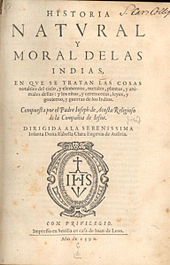
The Jesuits arrived in the Viceroyalty of Peru by 1571; it was a key area of the Spanish empire, with not only dense indigenous populations but also huge deposits of silver at Potosí. A major figure in the first wave of Jesuits was José de Acosta (1540–1600), whose book Historia natural y moral de las Indias (1590) introduced Europeans to Spain's American empire via fluid prose and keen observation and explanation, based on 15 years in Peru and some time in New Spain (Mexico). Viceroy of Peru Don Francisco de Toledo urged the Jesuits to evangelize the indigenous peoples of Peru, wanting to put them in charge of parishes, but Acosta adhered to the Jesuit position that they were not subject to the jurisdiction of bishops and to catechize in indigenous parishes would bring them into conflict with the bishops. For that reason, the Jesuits in Peru focused on education of elite men rather than the indigenous populations.[75]
To minister to newly arrived African slaves,
In 1639, the Audiencia of Quito organized an expedition to renew its exploration of the Amazon river and the Quito Jesuit (Jesuita Quiteño)
In 1637, the Jesuits Gaspar Cugia and Lucas de la Cueva from Quito began establishing the Mainas missions in territories on the banks of the Marañón River, around the Pongo de Manseriche region, close to the Spanish settlement of Borja. Between 1637 and 1652 there were 14 missions established along the Marañón River and its southern tributaries, the Huallaga and the Ucayali rivers. Jesuit Lucas de la Cueva and Raimundo de Santacruz opened up two new routes of communication with Quito, through the Pastaza and Napo rivers.

Between 1637 and 1715, Samuel Fritz founded 38 missions along the length of the Amazon river, between the Napo and Negro rivers, that were called the Omagua Missions. These missions were continually attacked by the Brazilian Bandeirantes beginning in the year 1705. In 1768, the only Omagua mission that was left was San Joaquin de Omaguas, since it had been moved to a new location on the Napo river away from the Bandeirantes.
In the immense territory of Maynas, the Jesuits of Quito made contact with a number of indigenous tribes which spoke 40 different languages, and founded a total of 173 Jesuit missions encompassing 150,000 inhabitants. Because of the constant epidemics (smallpox and measles) and warfare with other tribes and the Bandeirantes, the total number of Jesuit Missions were reduced to 40 by 1744. The Jesuit missions offered the indigenous people Christianity, iron tools, and a small degree of protection from the slavers and the colonists. In exchange, the indigenous had to submit to Jesuit discipline and adopt, at least superficially, a life style foreign to their experience. The population of the missions was only sustained by frequent expeditions into the jungle by Jesuits, soldiers, and Christian Indians to capture indigenous people and force them to return or to settle in the missions. At the time when the Jesuits were expelled from Spanish America in 1767, the Jesuits registered 36 missions run by 25 Jesuits in the Audiencia of Quito – 6 in the Napo and Aguarico Missions and 19 in the Pastaza and Iquitos Missions, with a population at 20,000 inhabitants.[78]
Paraguay
The Guaraní people of eastern Paraguay and neighboring Brazil and Argentina were in crisis in the early 17th century. Recurrent epidemics of European diseases had reduced their population by up 50 percent and the forced labor of the encomiendas by the Spanish and mestizo colonists had made virtual slaves of many. Franciscan missionaries began establishing missions called reductions in the 1580s.[79] The first Jesuits arrived in Asunción in 1588 and founded their first mission (or reduction) of San Ignacio Guazú in 1609. The objectives of the Jesuits were to make Christians of the Guaraní, impose European values and customs (which were regarded as essential to a Christian life), and isolate and protect the Guaraní from European colonists and slavers. "[79][80]
In addition to recurrent epidemics, the Guaraní were threatened by the slave-raiding
The opinions of historians differ with regard to the Jesuit missions. The missions are much-romanticized with the Guaraní portrayed as innocent children of nature and the Jesuits as their wise and benevolent guides to an earthly utopia. "Proponents...highlight that the Jesuits protected the Indians from exploitation and preserved the Guaraní language and other aspects of indigenous culture."
To the contrary the detractors say that 'the Jesuits took away the Indians' freedom, forced them to radically change their lifestyle, physically abused them, and subjected them to disease." Moreover, the missions were inefficient and their economic success "depended on subsidies from the Jesuit order, special protection and privileges from the Crown, and the lack of competition"[84] The Jesuits are portrayed as "exploiters" who "sought to create a kingdom independent of the Spanish and Portuguese Crowns."[85]
The Comunero Revolt (1721 to 1735) was a serious protest by Spanish and mestizo Paraguayans against the Jesuit missions. The residents of Paraguay violently protested the pro-Jesuit government of Paraguay, Jesuit control of Guaraní labor, and what they regarded as unfair competition for the market for products such as yerba mate. Although the revolt ultimately failed and the missions remained intact, the Jesuits were expelled from institutions they had created in Asunción.[86] In 1756, the Guaraní protested the relocation of seven missions, fighting (and losing) a brief war with both the Spanish and Portuguese. The Jesuits were accused of inciting the Guaraní to rebel.[87] In 1767, Charles III of Spain (1759–88) expelled the Jesuits from the Americas. The expulsion was part of an effort in the Bourbon Reforms to assert more Spanish control over its American colonies.[88] In total, 78 Jesuits departed from the missions leaving behind 89,000 Guaraní in 30 missions. [89]
Colonial Brazil

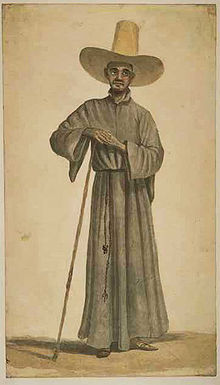
Tomé de Sousa, first Governor General of Brazil, brought the first group of Jesuits to the colony. The Jesuits were officially supported by the King, who instructed Tomé de Sousa to give them all the support needed to Christianize the indigenous peoples.
The first Jesuits, guided by
The success of the Jesuits in converting the indigenous peoples is linked to their efforts to understand the native cultures, especially their languages. The first grammar of the
The Jesuits had frequent disputes with other colonists who wanted to enslave the natives. The action of the Jesuits saved many natives from being enslaved by Europeans, but also disturbed their ancestral way of life and inadvertently helped spread infectious diseases against which the aborigines had no natural defenses. Slave labor and trade were essential for the economy of Brazil and other American colonies, and the Jesuits usually did not object to the enslavement of African peoples, but rather critiqued the conditions of slavery. [90] In cases where individual Jesuit priests criticised the institution of African slavery, they were censored and sent back to Europe.[91]
Suppression and restoration
The Suppression of the Jesuits in Portugal, France, the
Having further considered that the said Company of Jesus can no longer produce those abundant fruits, ... in the present case, we are determining upon the fate of a society classed among the mendicant orders, both by its institute and by its privileges; after a mature deliberation, we do, out of our certain knowledge, and the fulness of our apostolical power, suppress and abolish the said company: we deprive it of all activity whatever. ...And to this end a member of the regular clergy, recommendable for his prudence and sound morals, shall be chosen to preside over and govern the said houses; so that the name of the Company shall be, and is, for ever extinguished and suppressed.
— Dominus ac Redemptor[93]
The suppression was carried out on political grounds in all countries except Prussia for a time, and Russia, where Catherine the Great had forbidden its promulgation. Because millions of Catholics (including many Jesuits) lived in the Polish provinces recently part-annexed by the Kingdom of Prussia, the Society was able to maintain its continuity and carry on its work all through the stormy period of suppression. Subsequently, Pope Pius VI granted formal permission for the continuation of the society in Russia and Poland, with Stanisław Czerniewicz elected superior of the province in 1782. He was followed by Gabriel Lenkiewicz, Franciszek Kareu and Gabriel Gruber until 1805, all elected locally as Temporary Vicars General. Pope Pius VII had resolved during his captivity in France to restore the Jesuits universally, and on his return to Rome he did so without much delay. On 7 August 1814, with the bull Sollicitudo omnium ecclesiarum, he reversed the suppression of the society, and therewith another Polish Jesuit, Tadeusz Brzozowski, who had been elected as Superior in Russia in 1805, acquired universal jurisdiction. On his death in 1820 the Jesuits were expelled from Russia by tsar Alexander I.
The period following the Restoration of the Jesuits in 1814 was marked by tremendous growth, as evidenced by the large number of Jesuit colleges and universities established during the 19th century. During this time in the United States, 22 of the society's 28 universities were founded or taken over by the Jesuits. It has been suggested that the experience of suppression had served to heighten
In Switzerland, the
Early 20th century
In the Constitution of Norway from 1814, a relic from the earlier anti-Catholic laws of Denmark–Norway, Paragraph 2, known as the Jesuit clause, originally read: "The Evangelical-Lutheran religion remains the public religion of the State. Those inhabitants, who confess thereto, are bound to raise their children to the same. Jesuits and monastic orders are not permitted. Jews are still prohibited from entry to the Realm." Jews were first allowed into the realm in 1851 after the famous Norwegian poet Henrik Wergeland had campaigned for it. Monastic orders were permitted in 1897, but the ban on Jesuits was only lifted in 1956.[96]
Post-Vatican II
The 20th century witnessed both growth and decline of the order. Following a trend within the Catholic priesthood at large, Jesuit numbers peaked in the 1950s and have declined steadily since. Meanwhile, the number of Jesuit institutions has grown considerably, due in large part to a post–
In Latin America, the Jesuits had significant influence in the development of liberation theology, a movement that was controversial in the Catholic community after the negative assessment of it by Pope John Paul II in 1984.[98]
Under Superior General Pedro Arrupe, social justice and the preferential option for the poor emerged as dominant themes of the work of the Jesuits. When Arrupe was paralyzed by a stroke in 1981, Pope John Paul II, not entirely pleased with the progressive turn of the Jesuits, took the unusual step of appointing the venerable and aged Paolo Dezza for an interim to oversee "the authentic renewal of the Church",[99] instead of the progressive American priest Vincent O'Keefe whom Arrupe had preferred.[100] In 1983 John Paul gave leave for the Jesuits to appoint a successor to Arrupe.
On 16 November 1989, six Jesuit priests (
On 21 February 2001, the Jesuit priest Avery Dulles, an internationally known author, lecturer, and theologian, was created a cardinal of the Catholic Church by Pope John Paul II. The son of former Secretary of State John Foster Dulles, Avery Dulles was long known for his carefully reasoned argumentation and fidelity to the teaching office of the church. An author of 22 books and over 700 theological articles, Dulles died on 12 December 2008 at Fordham University, where he had taught for twenty years as the Laurence J. McGinley Professor of Religion and Society. He was, at his passing, one of ten Jesuit cardinals in the Catholic Church.
In 2002,

In April 2005,
On 2 February 2006, Peter Hans Kolvenbach informed members of the Society of Jesus that, with the consent of Pope Benedict XVI, he intended to step down as Superior General in 2008, the year he would turn 80.
On 22 April 2006, Feast of Our Lady, Mother of the Society of Jesus, Pope Benedict XVI greeted thousands of Jesuits on pilgrimage to Rome, and took the opportunity to thank God "for having granted to your Company the gift of men of extraordinary sanctity and of exceptional apostolic zeal such as St Ignatius of Loyola, St Francis Xavier, and Bl Peter Faber". He said "St Ignatius of Loyola was above all a man of God, who gave the first place of his life to God, to his greater glory and his greater service. He was a man of profound prayer, which found its center and its culmination in the daily Eucharistic Celebration."[105]
In May 2006, Benedict XVI also wrote a letter to Superior General Peter Hans Kolvenbach on the occasion of the 50th anniversary of Pope Pius XII's encyclical Haurietis aquas, on devotion to the Sacred Heart, because the Jesuits have always been "extremely active in the promotion of this essential devotion".[106] In his 3 November 2006 visit to the Pontifical Gregorian University, Benedict XVI cited the university as "one of the greatest services that the Society of Jesus carries out for the universal Church".[107]
The 35th General Congregation of the Society of Jesus convened on 5 January 2008 and elected Adolfo Nicolás as the new Superior General on 19 January 2008. In a letter to the Fathers of the Congregation, Benedict XVI wrote:[108]
As my Predecessors have said to you on various occasions, the Church needs you, relies on you and continues to turn to you with trust, particularly to reach those physical and spiritual places which others do not reach or have difficulty in reaching. Paul VI's words remain engraved on your hearts: "Wherever in the Church, even in the most difficult and extreme fields, at the crossroads of ideologies, in the social trenches, there has been and there is confrontation between the burning exigencies of man and the perennial message of the Gospel, here also there have been, and there are, Jesuits".
— Address to the 32nd General Congregation of the Jesuits, 3 December 1974; ORE, 12 December, n.2, p.4.
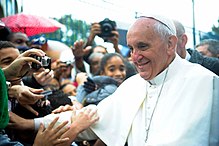
In 2013, Jesuit Cardinal Jorge Bergoglio became Pope Francis. Before he became pope, he was appointed bishop when he was in "virtual estrangement from the Jesuits" since he was seen as "an enemy of liberation theology" and viewed by others as "still far too orthodox". He was criticised for colluding with the Argentine junta, while biographers characterised him as working to save the lives of other Jesuits.[109][110][111] As a Jesuit pope, he has been stressing discernment over following rules, changing the culture of the clergy to steer away from clericalism and to move toward an ethic of service, i.e to have the "smell of sheep," staying close to the people.[112] After his papal election, the Superior General of the Jesuits Adolfo Nicolás praised Pope Francis as a "brother among brothers".[109]
On 2 October 2016, General Congregation 36 convened in Rome, convoked by Superior General Adolfo Nicolás, who had announced his intention to resign at age 80.[113][114][115] On 14 October, the 36th General Congregation of the Society of Jesus elected Arturo Sosa, a Venezuelan, as its thirty-first Superior General.[116]
The General Congregation of Jesuits who elected Arturo Sosa in 2016 asked him to bring to completion the process of discerning Jesuit priorities for the time ahead. Sosa devised a plan that enlisted all Jesuits and their lay collaborators in the process of discernment over a 16-month period. Then in February 2019 he presented the results of the discernment, a list of four priorities for Jesuit ministries for the next ten years.[117]
- To show the way to God through discernment and the
Spiritual Exercises of Ignatius of Loyola;- To walk with the poor, the outcasts of the world, those whose dignity has been violated, in a mission of reconciliation and justice;
- To accompany young people in the creation of a hope-filled future;
- To collaborate in the care of our Common Home.
Pope Francis gave his approval to these priorities, saying that they were in harmony with the church's present priorities and with the programmatic letter of his pontificate, Evangelii gaudium.[118]
Ignatian spirituality
The spirituality practiced by the Jesuits, called Ignatian spirituality, ultimately based on the Catholic faith and the gospels, is drawn from the Constitutions, The Letters, and Autobiography, and most specially from Ignatius'
Formation
The formation (training) of Jesuits seeks to prepare men spiritually, academically, and practically for the ministries they will be called to offer the church and world. Ignatius was strongly influenced by the
Governance of the society
The society is headed by a
The Father General is assisted by "assistants", four of whom are "assistants for provident care" and serve as general advisors and a sort of inner council, and several other regional assistants, each of whom heads an "assistancy", which is either a geographic area (for instance the North American Assistancy) or an area of ministry (for instance higher education). The assistants normally reside with Father General in Rome and along with others form an advisory council to the General. A vicar general and secretary of the society run day-to-day administration. The General is also required to have an admonitor, a confidential advisor whose task is to warn the General honestly and confidentially when he might be acting imprudently or contrary to the church's magisterium. The central staff of the General is known as the Curia.[119]
The society is divided into geographic areas called provinces, each of which is headed by a Provincial Superior, formally called Father Provincial, chosen by the Superior General. He has authority over all Jesuits and ministries in his area, and is assisted by a socius who acts as a sort of secretary and chief of staff. With the approval of the Superior General, the Provincial Superior appoints a novice master and a master of tertians to oversee formation, and rectors of local communities of Jesuits.[120] For better cooperation and apostolic efficacy in each continent, the Jesuit provinces are grouped into six Jesuit Conferences worldwide.
Each Jesuit community within a province is normally headed by a rector who is assisted by a "minister", from the Latin word for "servant", a priest who helps oversee the community's day-to-day needs.[121]
The General Congregation is a meeting of all of the assistants, provincials, and additional representatives who are elected by the professed Jesuits of each province. It meets irregularly and rarely, normally to elect a new superior general and/or to take up some major policy issues for the Order. The Superior General meets more regularly with smaller councils composed of just the provincials.[122]
Statistics
| Region | Jesuits | Percentage |
|---|---|---|
| Africa | 1,509 | 9% |
| South Latin America | 1,221 | 7% |
| North Latin America | 1,226 | 7% |
| South Asia | 4,016 | 23% |
| Asia-Pacific | 1,639 | 9% |
| Central and East Europe | 1,641 | 10% |
| South Europe | 2,027 | 12% |
| West Europe | 1,541 | 9% |
| North America | 2,467 | 14% |
| Total | 17,287 |
As of 2012[update], the Jesuits formed the largest single
The society is divided into 83 provinces along with six independent regions and ten dependent regions.[123] On 1 January 2007, members served in 112 nations on six continents with the largest number in India and the US.[citation needed] Their average age was 57.3 years: 63.4 years for priests, 29.9 years for scholastics, and 65.5 years for brothers.[22]
The current
Habit and dress
Jesuits do not have an official habit. The society's Constitutions gives the following instructions: "The clothing too should have three characteristics: first, it should be proper; second, conformed to the usage of the country of residence; and third, not contradictory to the poverty we profess." (Const. 577)
Historically, a Jesuit-style cassock which the Jesuits call Soutane became "standard issue": it is similar to a robe which is wrapped around the body and was tied with a cincture, rather than the customary buttoned front.[135] A tuftless biretta (only diocesan clergy wore tufts) and a ferraiolo (cape) completed the look.[136]
Today, most Jesuits in the United States wear the clerical collar and black clothing of ordinary priests.[137]
Controversies
Power-seeking
The Monita Secreta (Secret Instructions of the Jesuits), published in 1612 and in 1614 in Kraków, is alleged to have been written by Claudio Acquaviva, the fifth general of the society, but was probably written by former Jesuit Jerome Zahorowski. It purports to describe the methods to be adopted by Jesuits for the acquisition of greater power and influence for the society and for the Catholic Church. The Catholic Encyclopedia states the book is a forgery, fabricated to ascribe a sinister reputation to the Society of Jesus.[138]
| Separation of church and state in the history of the Catholic Church |
|---|
Political intrigue
The Jesuits were temporarily banished from France in 1594 after a man named Jean Châtel tried to assassinate the king of France, Henri IV. Under questioning, Châtel revealed that he had been educated by the Jesuits of the Collège de Clermont. The Jesuits were accused of inspiring Châtel's attack. Two of his former teachers were exiled and a third was hanged.[139] The Collège de Clermont was closed, and the building was confiscated. The Jesuits were banned from France, although this ban was quickly lifted.[140]
In England, Henry Garnet, one of the leading English Jesuits, was hanged for misprision of treason because of his knowledge of the Gunpowder Plot (1605). The Plot was the attempted assassination of James VI and I, his family, and most of the Protestant aristocracy in a single attack, by exploding the Houses of Parliament. Another Jesuit, Oswald Tesimond, managed to escape arrest for his involvement in this plot.[141]
Casuistic justification
Jesuits have been accused of using
Exclusion of those of Jewish or Muslim ancestry
Although in the first 30 years of the existence of the Society of Jesus there were many Jesuits who were conversos (Catholic-convert Jews), an anti-converso faction led to the Decree de genere (1593) which proclaimed that either Jewish or Muslim ancestry, no matter how distant, was an insurmountable impediment for admission to the Society of Jesus.[144] This new rule was contrary to the original wishes of Ignatius who "said that he would take it as a special grace from our Lord to come from Jewish lineage".[145] The 16th-century Decree de genere was repealed in 1946.[b]
Theological debates
Within the Catholic Church, there has existed a sometimes tense relationship between Jesuits and the
Religious persecution
In the quest to evangelize, Jesuits persecuted people of other religions, including Hindus, Muslims and other Christians. The Goan Inquisition was one among various persecutions that Jesuits were involved in. Voltaire wrote about the Goan Inquisition:[159][160]
Goa est malheureusement célèbre par son inquisition, également contraire à l'humanité et au commerce. Les moines portugais firent accroire que le peuple adorait le diable, et ce sont eux qui l'ont servi. [Goa is sadly famous for its inquisition, equally contrary to humanity and commerce. The Portuguese monks made us believe that the people worshipped the devil, and it is they who have served him.]
Nazi persecution
The Catholic Church faced
The Superior General of Jesuits at the outbreak of war was

Several Jesuits were prominent in the small
Among the Jesuit victims of the Nazis, Germany's Rupert Mayer has been beatified. Mayer was a Bavarian Jesuit who clashed with the Nazis as early as 1923. Continuing his critique following Hitler's rise to power, Mayer was imprisoned in 1939 and sent to Sachsenhausen death camp. As his health declined, the Nazis feared the creation of a martyr and sent him to the Abbey of Ettal in 1940. There he continued to give sermons and lectures against the evils of the Nazi régime, until his death in 1945.[174][175]
Rescue efforts during the Holocaust
In his history of the heroes of the Holocaust, the Jewish historian
Several other Jesuits are known to have rescued or given refuge to Jews during that period.[183] A plaque commemorating the 152 Jesuit priests who gave their lives during the Holocaust was installed in April 2007 at the Jesuits' Rockhurst University in Kansas City, Missouri, United States.

